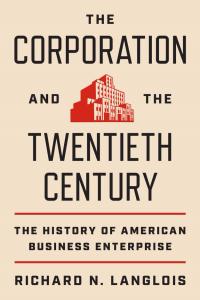Americans have in recent years become fascinated with the 1950’s and 60’s, as seen in the fascination with hit TV series like “Mad Men,” “The Marvelous Mrs. Maisel,” “Call the Midwife,” and so many others. The mid-to-late-twentieth century has acquired a sheen of romance, becoming in people’s imaginations an era of social connection, “good” jobs and prosperity.
But according to one UConn economist, these so-called golden years, which relied on the success of the modern American corporation, were far from what they seem in hindsight.
In “The Corporation and the Twentieth Century: The History of American Business Enterprise,” Richard Langlois, Professor and Head of Economics, explains how the American corporation rose to prominence, prospered, and eventually died a dismal death.
The book, which was favorably reviewed in the Wall Street Journal and the Financial Times and was picked as a Foreign Affairs best book of 2023, argues that although the corporation as an institution remains crucial to economic growth and prosperity, the large and extensive corporate structures that dominated much of the twentieth century were something of an aberration rather than a norm.
He writes that extensive managerial corporations were creatures of the mid–twentieth century’s economic and political events – the Depression, the New Deal, and World War II.
An Age of Rationalism
Imagine the world in the 19th century, with many small shops and factories trading with each other and through intermediate merchants. As the twentieth century dawns, says Langlois, that economy transforms.
“In the middle part of the century, suddenly large corporations are dominating business,” Langlois says. “And the question is: why?

“Before you get railroads and canals and telegraphs, it was very expensive to move goods around, so companies would produce things in the same place they were consumed,” says Langlois. “Once you have good transportation, you can have tremendous economies of scale, and then use the railroads to ship goods everywhere.”
Now, instead of each city having its own companies that produce goods, one corporation could sell a product all over the country, That, Langlois says, radically changed American society.
In his influential 1977 book “The Visible Hand,” renowned historian Alfred Chandler attributed this transition – away from small business and entrepreneurialism toward the hierarchies of corporations – to the inherent efficiency of managers in running large-scale, high-throughput business operations.
“Managerialism was created to have rational systems of communication and control in place,” explains Langlois. “Rationality, of which managerialism was one manifestation, became a hallmark of the century.”
Langlois challenges this prevailing narrative that managerialism’s rise to prominence stemmed from inherent superiority. He posits that it arose because of the unique circumstances of a young and rapidly evolving American economy – which made it more useful for companies to do everything “in-house.”
“Two businesses might coordinate with various forms of contracting,” Langlois explains. “So, I might hire you as my distributor and write a contract saying you can only distribute within a certain territory. That’s a market contract.
“Or, I could set up my own distributorship that I own, and now I’m sending products to my own distributor, within a firm where everything is under the same ownership structure.”
When and why this shift takes place is the crux of the rise of managerialism, he says.
Markets and Main Streets
Among the most important events of the 20th century, says Langlois, was the Great Depression. From about 1929-1939, economic markets collapsed. The New Deal, though created to bolster the economy, enacted policies and regulations that restricted markets, and World War II further crippled them.
In this environment in which markets were so weakened, Langlois says, businesses moved toward doing things within their own walls.
“During the Great Depression, small businesses and small stock exchanges were going out of business, and banks were failing at an alarming rate,” Langlois notes.
“So it was very hard to engage in market transactions or in complex transactions between firms. It was much easier and safer to do everything inside the organization.”
Further, he writes, the rise of aggressive antitrust policies had far-reaching and, in some cases, unintended consequences, such as creating an incentive to hide transactions from the scrutiny of public policy.
For example, in 1967, an antitrust case was brought successfully against the bicycle manufacturer Schwinn for enforcing exclusive dealership arrangements with its sellers and fixing its bicycles’ prices. The ruling overturned the earlier doctrine that manufacturers had the right to control the resale prices of their products.
“There were reasons for why you might want to have that kind of contract, the biggest of which was to ensure the sellers concentrated on sales and service rather than competing on price,” says Langlois.
But the courts declared this contract was a restraint of trade, establishing the principle that vertical price-fixing agreements could be considered anticompetitive, and were subject to scrutiny under antitrust laws.
The ruling made large companies start pulling their distributors under the umbrella of their firm.
“If Schwinn had owned its distributors, it would never have been sued, because it has the right to run its own distributorship,” points out Langlois. “If you make it hard for small businesses to contract with one another, then the more successful organizational form is going to be the large, vertically integrated companies that can own their own supply chains.”
The Rise of Knowledge Work
Thus, the U.S. entered the era of the corporation, the so-called “golden era” after World War II. But this romanticized portrayal of mid-century corporations also highlights the shift towards knowledge-intensive work, writes Langlois.
“It’s true that some people had good jobs in these corporations, but on the whole, people were much poorer than they are now,” he notes.

The postwar era saw a growing shift away from unskilled manufacturing jobs, which Langlois says is a hallmark of economic growth: economies move away from simple tasks for workers to more complicated cognitive tasks.
And, as the country began to prosper after the war and markets bounced back, extensive corporations began to lag in innovation and market share. In the late 20th century, says Langlois, the emergence of global markets and increased competition created a shift away from hierarchical structures toward more agile, flexible organizations.
Langlois writes that a crucial turning point was the invention of the microchip. Until this point, most innovations had developed in a relatively linear fashion. But the evolution of the microprocessors that would lead to computers and the explosion of modern technology was exponential.
That’s when American and overseas high-tech firms began to overtake the classic corporations like General Motors (GM), General Electric (GE), and DuPont.
“Over time, the microchip keeps becoming orders of magnitude more powerful and faster, and more data is able to be stored,” notes Langlois. “It’s made us realize that we believed we needed the hierarchical corporation, but [with the rise of technology] we don’t need it nearly as much anymore.”
A Step Back?
Some have criticized Langlois by pointing out that we still have big corporations now.
“And that’s certainly true,” he says. “But they’re in many ways not at all like the corporations of the middle part of the century. They’re much more specialized. Google, Amazon, Microsoft, Apple — they’re all high technology computing companies. They control much less of the supply chain.”
One notable and quite interesting exception, says Langlois, is Amazon. Employees’ tasks in Amazon warehouses, which can optimize operations at a large scale, resemble those on GM assembly lines. By managing all its logistics – and, more recently, delivery – in-house, it echoes historical precedents.
“Amazon is an exception – it makes sense because they’ve reached a scale where there are no diseconomies for them,” he says. “If you’re a really small outfit, like a local cookie shop, you’re not going to invest in your own trucks to deliver all over the country. But if you’re enormous, you don’t pay any penalty for integrating into your own trucks, because your deliveries are as big as FedEx and UPS.”
A major takeaway from his book, says Langlois, is that we tend to think of what we observe today as permanent. He points out that the shifts in business arising from artificial intelligence just in the last five years have proven that it is at best unhelpful and at worst negligent to create policy based on the assumption that business will remain unchanged.
“We think of Amazon, Apple and Microsoft in the way we know them today, forgetting that just ten years ago, they didn’t look like that,” he says. “It’s really hard for us to imagine what those companies are going to look like in the future. They can’t imagine it either.”



